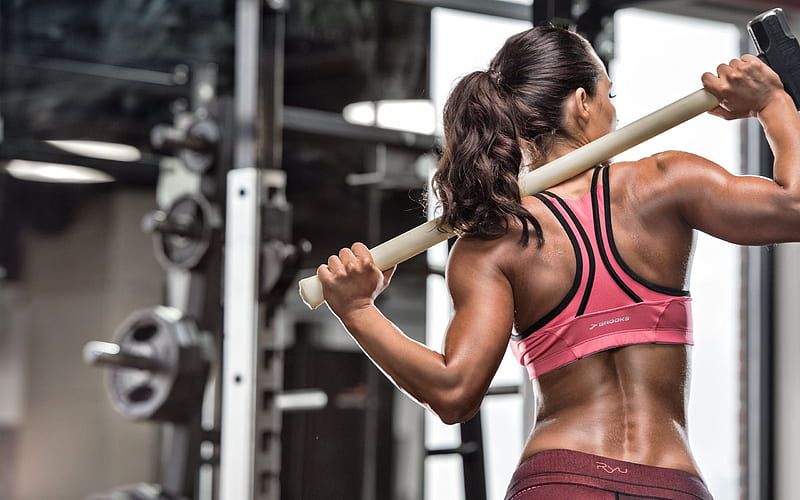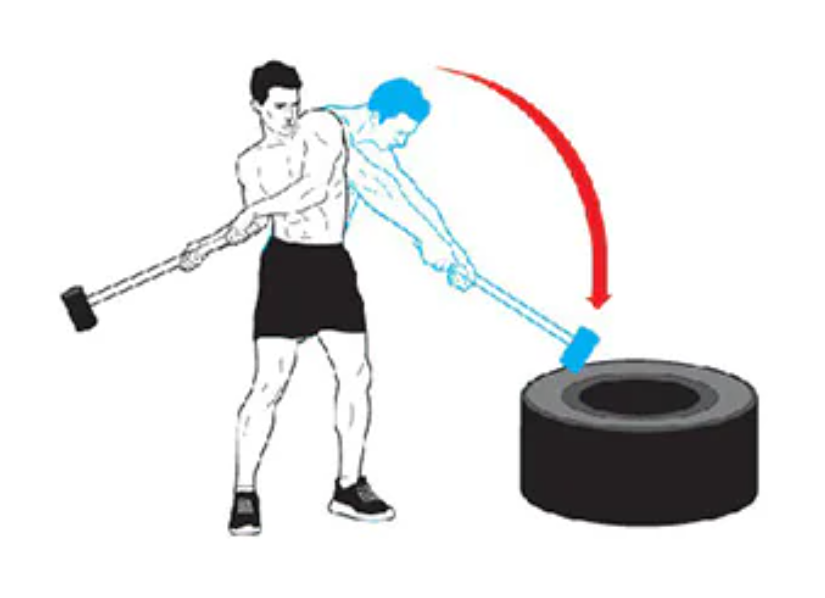Hammering, traditionally linked to construction and manual labor, is now making waves in the fitness world for its unexpected benefits in muscle building. Initially, the image of hammering may conjure thoughts of heavy-duty work rather than a workout regimen. However, recent discussions in fitness circles highlight hammering as a viable exercise that can contribute to muscle growth and overall physical conditioning.
This article delves into the effectiveness of hammering as a muscle-building exercise, examining its potential to enhance strength and endurance. We will explore how the repetitive swinging motion of hammering targets various muscle groups, and whether it can be a valuable addition to a well-rounded fitness routine. Additionally, we will compare hammering with traditional strength training methods, such as weightlifting, to understand its place in a comprehensive workout program.
Hammering Exercise Techniques
To maximize muscle-building benefits, mastering the proper hammering technique is crucial. Here’s a step-by-step guide:
- Positioning: Stand with feet shoulder-width apart, knees slightly bent. Hold the hammer with both hands, grip firmly but not overly tight.
- Swinging: Lift the hammer overhead with both hands and bring it down forcefully towards the target. Keep your movements controlled, focusing on precision.
- Engagement: Engage your core and maintain a neutral spine to stabilise your body. This ensures effective muscle engagement and reduces the risk of injury.
Targeted Muscle Groups
Hammering primarily targets the upper body muscles, including the shoulders, arms, and upper back. The repetitive swinging motion engages the deltoids, biceps, triceps, and latissimus dorsi, while also involving the core muscles to stabilize your body.
Hammering primarily targets:
- Upper Body: Shoulders (deltoids), arms (biceps and triceps), and upper back (latissimus dorsi).
- Core: Abdominals and obliques, as they stabilize your body during each swing.
Although hammering is less effective at isolating specific muscle groups compared to traditional weightlifting, it provides a unique way to enhance upper body strength and endurance. To prevent plateaus and keep workouts engaging, consider these variations:
- Weight Variations: Start with a lighter hammer and gradually increase the weight.
- Swing Patterns: Alternate between single-arm and double-arm swings or adjust the target area.
- Stance Variations: Perform exercises in different stances, such as single-leg or split-stance, to enhance stability and balance.
These variations challenge your muscles in different ways and contribute to continued progress.
Muscle Building Science
Mechanisms of Muscle Growth
Muscle growth, or hypertrophy, occurs when muscle fibers are subjected to stress and subsequently repair themselves, becoming thicker and stronger. The process involves three primary mechanisms: mechanical tension, muscle damage, and metabolic stress.
- Mechanical Tension: The stress placed on muscles during hammering can induce growth, particularly if performed with sufficient intensity.
- Muscle Damage: Repetitive swinging causes microtears in muscle fibers, which repair and grow stronger.
- Metabolic Stress: The sustained effort in hammering creates metabolic stress, contributing to muscle growth.
Hammering, through its repetitive and forceful nature, can induce mechanical tension and muscle damage, contributing to muscle growth. However, its effectiveness may vary compared to more traditional forms of resistance training.
Importance of Resistance Training
Resistance training is crucial for muscle building as it provides the necessary stimulus to elicit hypertrophy. By challenging the muscles with weights or resistance, the body adapts and grows stronger. Hammering, as a form of dynamic resistance exercise, can complement traditional strength training by offering an alternative stimulus and enhancing overall muscle endurance and power..
Factors Influencing Muscle Hypertrophy
Hammering can contribute to hypertrophy if performed with sufficient intensity and volume. Several factors influence muscle hypertrophy, including exercise intensity, volume, frequency, and recovery.
Several factors affect muscle growth:
- Intensity and Volume: Hammering can contribute to hypertrophy if performed with appropriate intensity and volume.
- Frequency: Integrate hammering with other resistance exercises to target different muscle groups and prevent overuse.
- Recovery: Ensure adequate rest and recovery between hammering sessions to facilitate muscle repair and growth.
However, it's essential to balance hammering with other forms of resistance training to address different muscle groups and ensure comprehensive development. Adequate recovery and nutrition are also vital for optimal muscle growth.
Hammering vs. Traditional Strength Training
Benefits and Drawbacks of Hammering
Benefits:
- Functional Strength: Enhances real-world strength and endurance.
- Grip Strength: Improves hand and forearm strength.
- Cardiovascular Challenge: Provides a cardiovascular workout due to the dynamic nature of the exercise.
Drawbacks:
- Limited Isolation: Less effective for isolating specific muscle groups compared to weightlifting.
- Risk of Injury: Potential for injury if not performed with proper form and technique.
How does Hammering differ from Weightlifting?
Weightlifting is a core element of strength training, designed to build muscle, enhance strength, and improve fitness through the use of free weights and resistance machines. It focuses on isolating specific muscle groups with controlled resistance and progressive overload, making it effective for targeted muscle development and achieving fitness goals.
In contrast, hammering is a dynamic exercise traditionally linked to manual labor. It emphasizes functional training by engaging multiple muscle groups through swinging motions, which enhances overall strength, endurance, and cardiovascular fitness. Hammering’s focus on full-body engagement and versatility makes it a valuable complement to traditional weightlifting, adding variety and functional strength to your fitness routine.
Here’s a comparison between hammering and weightlifting presented in a tabular format:
|
Aspect |
Weightlifting |
Hammering |
|
Targeted Muscle Isolation |
Allows precise targeting of specific muscle groups (e.g., biceps, triceps, quads). |
Engages multiple muscle groups simultaneously, focusing on overall functional strength. |
|
Controlled Resistance |
Provides adjustable resistance for progressive overload, crucial for muscle growth. |
Lacks precise resistance control but allows for varied weight and intensity through hammer weight and swing patterns. |
|
Training Focus |
Focuses on muscle isolation and strength development through specific exercises. |
Emphasises dynamic, full-body movements and functional training. |
|
Versatility |
Limited to the specific exercises and weights used; less variety in movement. |
Highly versatile; allows for varied swing patterns, weights, and stances. |
|
Functional Training |
Primarily targets muscle groups for strength and hypertrophy. |
Enhances practical strength, coordination, and endurance, mimicking real-world activities. |
|
Exercise Variations |
Includes diverse exercises (e.g., squats, deadlifts) with controlled resistance. |
Offers variations in swing patterns, stance, and hammer weight for different challenges. |
|
Integration |
Ideal for targeted muscle development and progressive overload. |
Complements weightlifting by adding functional strength and variety to the workout routine. |
Both weightlifting and hammering contribute to muscle building and overall fitness but do so through different mechanisms. Weightlifting provides targeted muscle isolation and controlled resistance, while hammering offers functional training and dynamic variety. Understanding the strengths of each can help in creating a well-rounded fitness program that combines the benefits of both approaches.
Incorporating hammering into your workout routine can enhance overall fitness by providing a different type of resistance and challenge. For instance, you might start with weightlifting exercises like squats or deadlifts to build targeted muscle strength and then follow up with hammering to improve functional strength and endurance. Integrating hammering 1-2 times per week alongside traditional strength training helps maintain a balanced approach and prevent workout monotony.
How can you incorporate hammering into your workout routine?
Incorporating hammering into your workout routine can be an effective way to add variety and enhance overall fitness. Here’s a guide on how to seamlessly integrate hammering into your routine:
Warm-Up
Start with a dynamic warm-up to prepare your body for both weightlifting and hammering. Include light cardio exercises (e.g., jogging, jumping jacks) and dynamic stretches to increase blood flow and flexibility. This will help prevent injuries and improve performance during your workout.
Strength Training
Begin your workout with traditional strength training exercises. These can include:
- Lower Body Exercises: Squats, deadlifts, lunges.
- Upper Body Exercises: Bench presses, rows, shoulder presses.
These exercises target specific muscle groups with controlled resistance and progressive overload, building strength and muscle mass.
Incorporate Hammering
After completing your strength training, incorporate hammering to focus on functional strength and endurance. You can do this as a standalone workout or as a part of your regular routine.
Example Hammering Routine
- Warm-Up: Perform a few light swings with the hammer to get used to the motion.
- Main Set: Execute 3-4 sets of 10-15 swings per side, depending on your fitness level and the weight of the hammer.
- Variation: You can vary the intensity by using a heavier hammer, adjusting swing angles, or incorporating different patterns (e.g., overhead swings, side swings).
Benefits: Hammering enhances grip strength, coordination, and overall functional fitness. It engages multiple muscle groups and provides a cardiovascular challenge, complementing the targeted muscle development from strength training.
Cool Down and Stretching
After your workout, take time to cool down and stretch. Focus on the muscles worked during both weightlifting and hammering:
- Static Stretching: Stretch your major muscle groups to promote flexibility and aid recovery.
- Foam Rolling: Use a foam roller to release muscle tension and improve circulation.
Frequency and Scheduling
Aim to include hammering in your routine 1-2 times per week. This allows you to balance the benefits of functional training with the targeted focus of strength training.
Example Weekly Schedule
- Monday: Strength training (lower body)
- Tuesday: Hammering workout
- Wednesday: Rest or light cardio
- Thursday: Strength training (upper body)
- Friday: Hammering workout
- Saturday: Rest or active recovery
- Sunday: Optional full-body workout or rest
Progression and Adaptation
As you become more comfortable with hammering, it's important to focus on progression and adaptation to continue making gains and avoiding plateaus.
- Start by increasing the intensity of your hammering workouts. One way to do this is by adding weight—using a heavier hammer will provide a greater challenge to your muscles, promoting further strength and endurance development.
- Additionally, consider increasing the volume of your workouts; performing more sets or swings can help build your stamina and enhance muscle endurance.
- Another effective strategy is to introduce variations into your hammering routine. Experiment with different hammering techniques, such as altering the swing patterns or angles, or incorporate interval training to boost the intensity and cardiovascular benefits.
By systematically adjusting these variables, you can ensure that your hammering routine remains challenging and continues to contribute to your overall fitness progress.
By integrating hammering into your workout routine with these guidelines, you can enhance both muscle development and functional strength, creating a balanced and effective fitness program.
Hammering for Beginners
For those new to hammering, safety and technique are paramount. Start with a lighter hammer to practice your form before progressing to heavier weights. Using protective gear, such as gloves and safety glasses, can help prevent injuries. Pay close attention to your body’s signals, and avoid pushing yourself too hard to minimize the risk of overexertion.
A beginner’s routine should start with basic hammering exercises, performing 2-3 sets of 10-15 repetitions. Warm up with light cardio and dynamic stretches to prepare your muscles for the workout, and cool down with stretching to aid recovery. As you build strength and confidence, gradually increase the hammer’s weight and explore different exercise variations to continue challenging your muscles.
Progression Tips for Novices
- Set Goals: Define clear fitness goals and track your progress.
- Adjust Routine: Gradually increase intensity and volume based on your progress.
- Variety: Incorporate different hammering variations to challenge your muscles and prevent plateaus.
Nutrition for Muscle Building
Proper nutrition is essential for supporting muscle growth alongside your hammering workouts. Protein is a critical component of muscle repair and growth, with recommendations typically ranging from 1.2-2.2 grams of protein per kilogram of body weight daily. Include high-quality protein sources such as lean meats, fish, eggs, dairy products, and plant-based proteins in your diet.
In addition to protein, ensure a balanced intake of carbohydrates and fats to support energy levels and overall health. Carbohydrates fuel your workouts, while fats are important for hormone production and overall well being. A varied diet rich in fruits, vegetables, whole grains, and healthy fats will complement your muscle-building efforts.
Nutritional strategies surrounding your workouts are also important. Consume a balanced meal with carbohydrates and protein 1-2 hours before exercising to fuel your workout. After training, eat a meal or snack with protein and carbohydrates within 30 minutes to aid recovery. Staying hydrated by drinking plenty of water throughout the day and during workouts is crucial for optimal performance and recovery.
Pre and Post-Workout Nutrition Strategies
Pre-Workout: Consume a balanced meal with carbohydrates and protein 1-2 hours before exercise.
Post-Workout: Eat a meal or snack with protein and carbohydrates within 30 minutes after training to support recovery.
Hydration: Drink water throughout the day and during workouts to stay hydrated.
Conclusion
Hammering can be a valuable addition to a muscle-building routine, offering unique benefits such as functional strength, endurance, and grip strength. While it may not completely replace traditional strength training, it provides a complementary challenge that enhances overall fitness. By integrating hammering with other resistance exercises, adhering to proper technique, and supporting your workouts with appropriate nutrition, you can maximize its benefits and achieve your muscle-building goals. Challenge yourself to include hammering in your routine and observe the results. Share your experiences or ask questions in the comments below!










